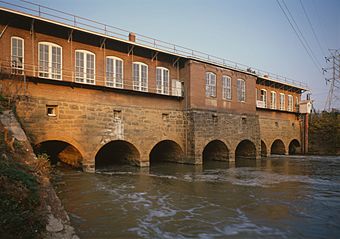Columbia Canal facts for kids
Quick facts for kids |
|
|
Columbia Canal
|
|

Columbia Canal Power Plant and Canal Races
|
|
| Location | E bank of the Broad and Congaree Rivers from the Diversion dam to the Southern RR Bridge Richland County, South Carolina |
|---|---|
| Nearest city | Columbia, South Carolina |
| Built | 1824 & 1893 |
| NRHP reference No. | 79002392 |
| Added to NRHP | 15 January 1979 |
The Columbia Canal is an important historical canal in Columbia, South Carolina. It was first built in 1824 by the State of South Carolina. Many Irish workers helped build it. The canal was made to create easy water routes for boats. This helped connect towns in the upstate areas with cities closer to the Atlantic Ocean.
Today, the canal is a main part of Riverfront Park in Columbia. It is also used to create electricity from water power. The South Carolina Electric & Gas Co. operates this power plant.
The Columbia Canal is listed on the National Register of Historic Places. This means it is a special historical site. You can find more information and pictures about it from the South Carolina Department of Archives and History. The Historic American Engineering Record at the Library of Congress also has details.
Contents
History
The First Canal (1824)
Work on the Columbia Canal began in 1820. Its goal was to help boats get around the fast-moving water where the Broad River and the Saluda River meet. This meeting point forms the Congaree River. The canal followed a natural valley between Columbia and the rivers.
The canal was finished in 1824. It was about 3.1 miles (5 km) long. In some parts, it was 12 feet (3.7 m) wide and 2.5 feet (0.8 m) deep. In other parts, it was wider and deeper. There were paths on both sides for animals to pull boats. The canal also had four special "locks" and one guard lock. These locks helped boats move up or down the river's 34-foot (10 m) drop.
A special dam was built across the Broad River. This dam helped water flow into the canal. It also allowed boats to connect from the Saluda Canal. Three "weirs" were also built. These were like overflow gates to stop the canal from flooding.
Another smaller canal, called Bull Sluice, was built north of the Columbia Canal. It was about half a mile (0.8 km) long and had one lock. Later, the 1891 canal connected to this Bull Sluice area.
By 1840, the state stopped funding the canal. When railroads came to Columbia in 1842, fewer boats used the canal. During the American Civil War, the canal's water power was used to make gunpowder. Mills along the canal also used its power to grind grain and cut wood.
Some parts of the original 1824 canal still exist today. Parts of the Bull Sluice canal are also still there.
The New Canal (1891)
In 1888, the canal was updated to create power for factories. The new design started at Gervais Street. It stretched about 3.5 miles (5.6 km) north along the Congaree and Broad Rivers. This new canal was much bigger. It was about 150 feet (46 m) wide and 10 feet (3 m) deep. It also included a new dam, an entry lock, and a waste weir. The updated canal opened in 1891.
The Columbia Mill was built nearby. A power plant was constructed on the canal about 600 feet (183 m) away. This plant generated electricity for the mill. This was very advanced for the time. It was the first textile mill in the world to use AC (alternating current) motors. It was also the first to generate power away from the main mill building.
The Columbia Hydro plant was built at the canal's southern end. This plant made electricity for factories, the city of Columbia, and the streetcar system. The South Carolina Electric & Gas Co. once ran this plant.
Irish Memorial (2008)
In September 2008, a special memorial was dedicated. It honors the Irish workers who built the Columbia Canal. This granite memorial is called the South Carolina Irish Memorial. It remembers the many Irish workers who built and died while digging this canal. Many of them are buried at the nearby St. Peter's Catholic Church.
Flooding and Repairs (2015)
In October 2015, there was a huge flood. The canal was damaged during this event. The South Carolina Army National Guard worked hard to fix the canal.


